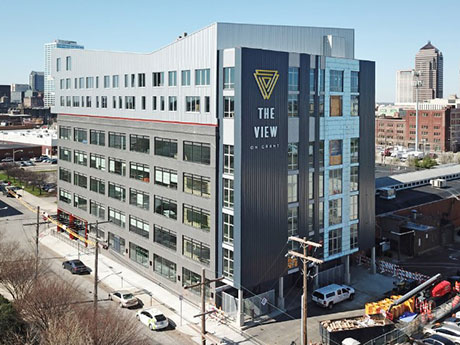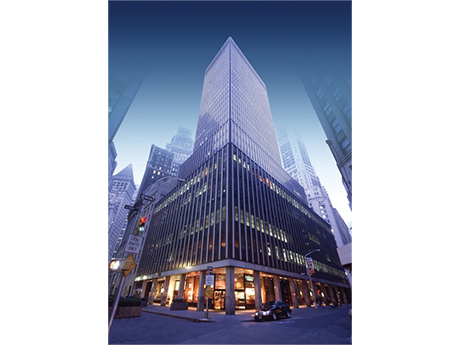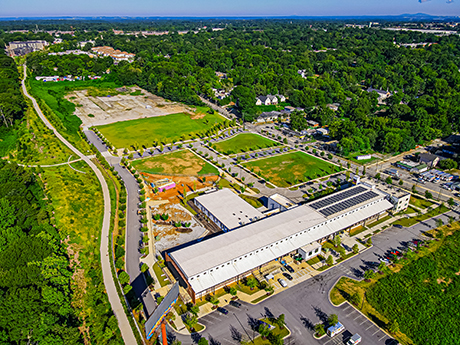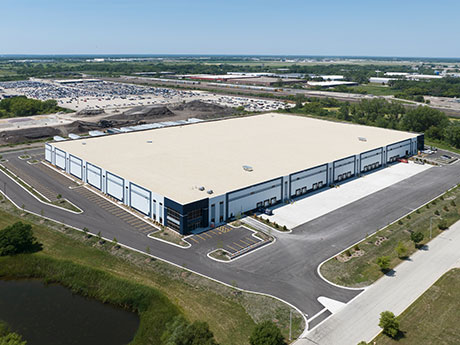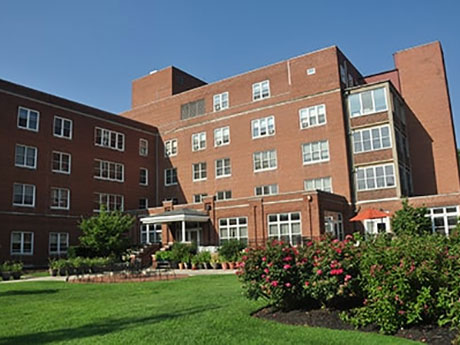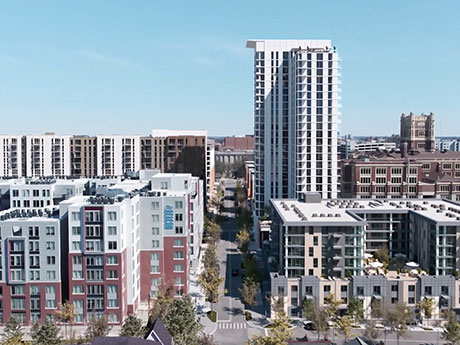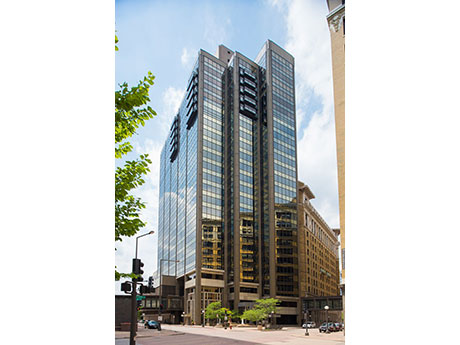MENLO PARK, CALIF. — Presidio Bay Ventures, a San Francisco-based developer and investment firm, has officially opened Springline, a 6.4-acre mixed-use development near downtown Menlo Park in Silicon Valley. Situated adjacent to the Cal Train Station, the development features 200,000 square feet of office space, The Residences at Springline apartment community, a central plaza, two underground parking garages and 29,000 square feet of retail space. “We have delivered a magnetic destination in the heart of Silicon Valley that attracts the Bay area’s best to live, work and play,” says K. Cyrus Sanandaji, managing principal of Presidio Bay. “Over the past three years, we have created a destination with thoughtfully designed spaces that allow for tenants, residents and the local community to interact.” The Offices at Springline spans two buildings and features coworking space in the south building, as well as a golf simulator, entertainment lounge, fitness center, locker rooms, showers, outdoor fitness spaces, bicycle parking, electric vehicle charging stations and The Glade, an onsite dog park. Office tenants also have access to the Springline App that allows remote entry, direct access to property management, amenities, bookings and other services. The Offices are fully leased to global and regional tenants, including STG, Menlo Ventures, …
Search results for
"Adaptive Reuse"
COLUMBUS, OHIO — Colliers Mortgage has provided a $10.8 million Fannie Mae loan for the acquisition of The View on Grant, an 86-unit apartment complex in Columbus. The property, situated in the Discovery District, is an adaptive reuse of a former five-story steel pressing factory. The community features a public café and a 43-space, automatic stacked parking garage. Zach Shope of Colliers originated the 10-year loan on behalf of the borrower, VOG Owner LLC.
By Ryan Kimura, senior vice president of strategic partnerships, Premier The changing landscape of work and the future of the office remains in flux, leading to a reduced demand for office space in major metropolitan areas throughout the country. This shift has rendered many office buildings underutilized and obsolete, prompting developers and investors to seek alternative uses for these structures. Simultaneously, urbanization continues to grow, fueling the demand for housing and a need for innovative multifamily solutions. Office-to-multifamily conversions provide an answer to both challenges, repurposing office spaces into much-needed residential units while allowing investors to capitalize on demand. This perfect storm of reduced office demand, increased housing needs and favorable regulatory conditions has driven the popularity of office-to-multifamily conversions, positioning them as a sustainable strategy for urban development. These conversions began to surge in popular metro areas during the height of the pandemic as uncertainty surrounded the return to the workplace. Fast forward three years later and office conversions are still booming — especially in the Dallas market. The region, which has witnessed some of the largest population increase in the country over the past five years, has also had a double-digit office vacancy rate in its downtown area …
POUGHKEEPSIE, N.Y. — Locally based developer PAZ Management has begun leasing The Flats at Raymond, a 39-unit multifamily project located north of New York City in Poughkeepsie. The property features one- and two-bedroom units ranging in size from 706 to 1,098 square feet. The Flats at Raymond is one of two complexes that comprise the first phase of a larger development known as The Arlington of Poughkeepsie. The second property, a 24-unit adaptive reuse project known as Lofts at The School, began welcoming residents earlier this year and is now 90 percent occupied. Rents at The Flats at Raymond start at $1,975 per month.
Atlanta BeltLine Inc. Completes $13.3M Land Purchase Along Southside Trail in Southwest Atlanta
by John Nelson
ATLANTA — Atlanta BeltLine Inc. has purchased 13.7 acres along the BeltLine’s Southside Trail in southwest Atlanta for $13.3 million. Situated at 356 University Ave., the property is situated adjacent to the Pittsburgh Yards adaptive reuse development. This acquisition marks the continuation of the BeltLIne’s mission to procure land along the trail loop. AECF Atlanta Realty, a subsidiary of the Annie E. Casey Foundation, manages Pittsburgh Yards and was the seller. SouthState Bank provided acquisition financing for the transaction. The BeltLine will conduct a community engagement process to determine best uses for the site. After incorporating the vision of adjacent residents and local businesses into the plans, the organization will issue a Request for Proposals (RFPs) to invite developers to submit proposals to redevelop the site.
By John Cassidy and Calvin Gunn, Lee & Associates If you love a good groundbreaking photo — full of shiny shovels, hard hats and smiling development teams — you may be disappointed this year, for all the best reasons. With Chicago’s most recent wave of speculative industrial projects currently being delivered, the market now actually has space to offer industrial tenants — a refreshing change from the past few years. With construction costs and interest rates continuing to rise and credit availability shrinking, many developers with ties to Chicago are pausing new projects as exit cap rates are becoming more difficult to predict. At the same time, market fundamentals are starting to cool from the pandemic-era eruption of demand. The good news: Chicago’s industrial market may be down from the clouds, but it’s still historically quite healthy. Vacancy rate in perspective According to Lee & Associates of Illinois’ second-quarter industrial snapshot, construction deliveries caused the Chicago industrial vacancy rate to tick upward for the second consecutive quarter. However, a 3.68 percent vacant market is still considered a historically low vacancy environment. As a comparison, that vacancy rate measured about 12 percent at the end of 2009 and 6.6 percent in …
KeyBank Structures $9.9M in LIHTC Equity for Affordable Seniors Housing Project in Cleveland Heights
CLEVELAND HEIGHTS, OHIO — KeyBank Community Development Lending and Investment has structured $9.9 million in Low Income Housing Tax Credit (LIHTC) equity to finance the conversion of the Margaret Wagner Senior Apartments in Cleveland Heights into 80 low-income seniors housing units. The project will create 20 new units through the adaptive reuse of the first floor of Margaret Wagner House and preserve 60 units on the upper floors. Built in 1960 as a nursing home by the Benjamin Rose Institute on Aging, the facility features a HUD 202 Project Rental Assistance Contract subsidy for all of its units. In addition to creating 20 new units, the project will also renovate existing units with updated kitchens and bathrooms, improved accessibility, central air conditioning, elevator modernization, new roofing and site improvements. The project’s total cost is $18.7 million. Additional funding comes from a HUD 202 Capital Advance, Cuyahoga County HOME and Affordable Housing Gap funding, Affordable Housing Program Grant funding through the Federal Home Loan Bank of Boston and seller financing. CHN Housing Partners and Benjamin Rose, both of which are Cleveland-based organizations, are co-developing the project. Derek Reed of KeyBank structured the LIHTC tax credit equity investment and Tara Miller served …
ATLANTA — Selig Enterprises and joint venture partner GID will open Westbound at The Works, a 306-unit apartment community located within The Works mixed-use development, this October. Located in Atlanta’s Upper Westside neighborhood, the five-story property features residences ranging in size from 731 to 1,353 square feet in one- and two-bedroom layouts, with a 547-space parking garage. Amenities include an open-air TV lounge, fitness center, club room, sports bar, coworking center, communal kitchens and a pool courtyard. RJTR is the project architect, and Brasfield & Gorrie is the general contractor. Wells Fargo provided financing for the development. RangeWater will manage and lease the property, with monthly rates beginning at $1,840, according to the community’s website. Developed in phases by Selig, The Works also features retail and entertainment space, including a food hall, as well as 125,000 square feet of adaptive reuse office space.
By Anthony Armbruster, Colliers Although converting former office buildings to multifamily properties is by no means a new practice, conversions have been on the rise in recent years due to the changing work environment and office landscape. While the COVID-19 pandemic has started to fade away in many peoples’ minds, several of the changes in the work environment during that time have not. Many formerly in-office employees continue to work from home or have hybrid schedules post-pandemic. Additionally, tenants who are moving into new office spaces have shown a preference for smaller, more efficiently laid out, amenity-rich and suburban Class A office spaces. These changing consumer preferences have resulted in higher vacancies and fewer new tenants for older downtown office buildings than before the pandemic. Consequently, many of these older buildings are being converted into residential spaces, exemplifying the trend. An office building may be considered for a residential conversion when it is no longer economically feasible to continue running the building as such. However, not every office building at the end of its economically useful life is a suitable candidate for a residential conversion. Factors such as a building’s layout, location, age and cost of conversion play the most …
There’s no denying the office sector is undergoing a critical period marked by myriad challenges. The question is, how will it all turn out? Currently, the inventory of U.S. office space is 5.56 billion square feet — and will likely reach over 5.68 billion square feet by the end of the decade. But today’s “flexible” workforce will only require 4.61 billion square feet to accommodate its needs, according to a Cushman & Wakefield report titled “Obsolescence Equals Opportunity.” “The U.S. will end the decade with 1.1 billion square feet of vacant office space, 740 million square feet of which qualifies as normal or natural vacancy and 330 million square feet of which qualifies as excess vacancy attributable to remote and hybrid strategies,” the report states. “The overall level of vacancy will therefore be 55 percent higher than was observed prior to the pandemic.” Those numbers are jarring, but opportunists say the office sector just needs to evolve and adapt, much like the retail market has done. “Just as retail didn’t die in the years following the e-commerce boom, the office sector is not in danger of demise,” states the Cushman & Wakefield report. “Recognizing the challenges and opportunities head-on with …


